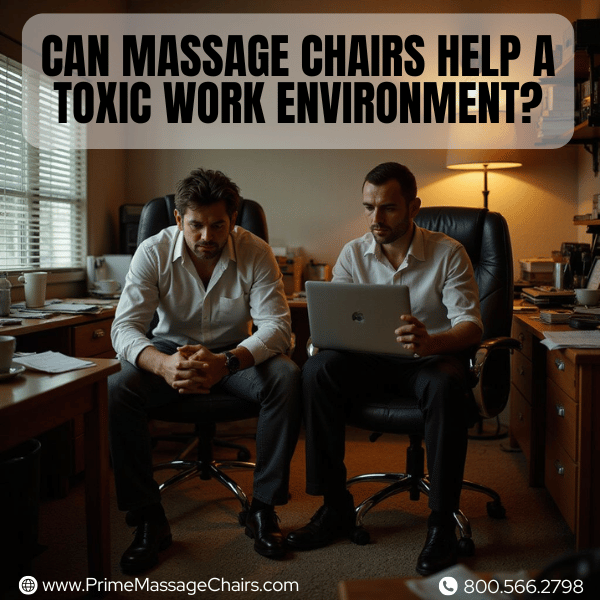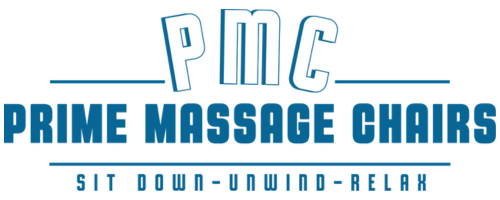
Can Massage Chairs Help a Toxic Work Environment?
Can massage chairs help a toxic work environment? massage chairs may be a great solution for employees who could be experiencing stress on a daily basis.
This article discusses how introducing massage chairs may enhance the office setting.
Keep reading to learn more!
The Role of Massage Chairs in Workplace Wellness
Massage chairs in workplaces may help people feel more comfortable by offering a way to relax and take breaks from long hours of sitting.
Alleviating Stress and Anxiety
Work stress may cause many people to miss work daily. Massage chairs could help reduce this problem by lowering cortisol, the body's stress hormone, though the effects may vary from person to person.

This reduction may help employees feel more relaxed and less anxious. Even short sessions in a massage chair may help lower stress at work.
These moments of relaxation may also support health. With lower stress hormones, mood and mental wellness could improve for everyone in the office.
Installing massage chairs may help create a calming atmosphere where employees may find peace amid their busy schedules.
Reducing Physical Discomfort and Tension
Sitting at a desk for hours may cause neck, shoulder, and lower back pain.
Massage chairs could help by focusing on these areas with deep tissue techniques. They may ease muscle tension and decrease stiffness.
This could help people feel better more quickly. These chairs may also support blood circulation.
With improved flow, more oxygen may reach the muscles. This may support healing and lessen chronic pain from sitting or stress.
Using massage chairs regularly may help stop tension buildup. It could keep employees feeling good and support focus.
Promoting Relaxation and Mental Clarity
Massage chairs may offer a soothing experience that helps people feel more at ease and mentally refreshed.
Using them for short breaks could prevent mental fatigue, which may support decision-making and creativity. These sessions might reduce stress and support focus during work tasks.
Less tension in body and mind may make employees more comfortable, possibly leading to better problem-solving skills at work.
Positive Effects on Employees
Massage chairs in the workplace may boost happiness, ease stress, improve focus, and lead to fewer sick days.
Improved Mood and Emotional Well-being
Using a massage chair may boost happiness and lower stress. Research suggests that massages could increase mood and energy by releasing endorphins, chemicals that create positive feelings.

Massage chairs at work may provide a calming experience that helps employees unwind and feel more at ease.
Regular sessions in a massage chair may lead to better mental health by helping reduce anxiety levels.
This improvement in mood could help remove negative emotions from the workplace, creating a better environment for all.
With happier employees, concentration may improve, possibly leading to better job performance.
Enhanced Focus and Productivity
Improved mood may support better work performance.
Massage chairs could help with this by lowering stress and clearing the mind. As a result, employees may focus better and complete tasks more efficiently.
Adding commercial massage chairs to the workplace may help improve work output. These chairs might enhance blood circulation, which could support sharper thinking and increased alertness.
Employees may feel valued, motivating them to contribute more effectively.
Reduced Absenteeism
Stress may cause people to miss work. Massage chairs could help reduce this issue by supporting general well-being, though their effect on sick days is mostly based on personal experiences.
Employees with access to massage chairs may report higher job satisfaction, which could lead to increased productivity and lower turnover rates.
This improvement in employee well-being may reduce the need for frequent hiring, helping companies save time and resources.
Positive Effects on Workplace Culture
Massage chairs may improve workplace wellness, supporting teamwork and morale. They could encourage a positive work environment where health is a priority.
Boosted Morale and Team Collaboration
Massage chairs may signal to employees that their health is important.
This could boost morale and foster a sense of unity in the workplace. Teams might communicate better and solve problems more effectively.
These chairs may support a wellness-focused work environment. Stress levels could drop, energy may increase, and collaboration on team projects might improve.
Reduced tension may lead to fewer sick days and better team performance overall.
Creation of a Wellness-Centered Environment
Massage chairs may help create a health-focused work environment. They may show that the company values employee health, making staff feel appreciated.
Using massage chairs could help employees unwind and lower their stress levels, boosting happiness on the job.
Training leaders to improve workplace conditions may be helpful. Employee Assistance Programs (EAPs) might be useful for addressing negative behaviors effectively, supporting a safe and welcoming work atmosphere.
Caring for employee well-being could enhance the overall mood at work.
Encouragement of Regular Breaks
Placing massage chairs in the break room may encourage employees to take regular breaks.
These breaks might reduce mental fatigue by letting workers step away and recharge. As a result, they could return with better focus and more energy.
This practice may help prevent muscle tension and support a healthier work life through relaxation.
Employees using these chairs for just a few minutes could feel more relaxed and energized.
Implementing Massage Chairs in the Workplace
To integrate premium massage chairs into workplace wellness programs, businesses may consider selecting models that could meet office needs and encourage employee feedback.
- Choose appropriate massage chairs that may suit your business.
- Incorporate them into existing wellness initiatives.
- Gather worker opinions on their possible effectiveness.
Choosing the Right Massage Chair for Office Needs
Choosing the right massage chair for an office may involve balancing employee needs, general cost considerations, and available features.
Some models could include more advanced options, such as heating, adjustable intensity, or multiple massage modes, while simpler chairs might focus on basic comfort and relaxation.

Office managers and even store managers may identify what employees prefer. Some could seek deep tissue massages to ease tight muscles while others might prefer gentle massages to relax during busy days.
It may be helpful to select chairs that provide various massage techniques without exceeding general budget considerations.
Options could cater to diverse preferences and remain suitable for an office setting.
Integrating Chairs into Existing Wellness Programs
Introducing massage chairs to wellness programs could show care for employees.
Businesses may find a quiet, welcoming spot for the chairs dedicated to relaxation, as this may help reduce distractions and enhance the calming experience.
Feedback from employees after using the chairs may help improve the experience. Selecting the right chair may involve considering employee needs and general affordability.
Encouraging employee engagement with these new massage options could enhance wellness program success.
Encouraging Employee Engagement and Feedback
Setting up massage chairs in wellness programs and offering an easy way to book sessions, like sign-up sheets or an online system, may let employees choose a time with ease.
To see how the program may be working, businesses could collect feedback from employees.
Asking if the massage chair sessions help lower their stress or discomfort might guide improvements. Surveys or polls may help gather this information quickly.
Then, adjustments could be made to the program based on feedback. This approach may show care for employee well-being and invite input on improving workplace culture.
Potential Challenges and Considerations
Before introducing massage chairs into the workplace, businesses may want to consider potential distractions and ensure all employees could have access to prevent feelings of exclusion.
Addressing Concerns About Distraction
Some believe massage chairs might make employees lose focus on work. However, setting up a massage schedule could help manage this.

Companies may plan massage times so they do not disrupt work. This approach might allow everyone to enjoy a turn without slowing down their tasks.
Also, companies could offer massages during breaks or free time. Employees may relax with a short massage without missing work duties. By organizing timing thoughtfully, massage chairs could support workplace productivity.
Ensuring Accessibility for All Employees
To support all employees, including those with disabilities, workplaces may aim to ensure massage chairs are accessible. A positive work environment might come from caring for everyone's needs.
Companies could regularly check and remove any barriers that may prevent full use of wellness programs.
This might include physical space limitations, policy restrictions, or lack of employee awareness, as well as setting aside a budget for accessibility features, adjusting management approaches, and choosing chairs that could meet diverse needs.
Doing this may show that the company values employee well-being and wishes to make the workplace welcoming for everyone.
By making wellness programs like massage chair sessions available to all staff members, businesses could help change a negative atmosphere into a more supportive space.
This approach may support employee retention and overall workplace morale by showing that each team member's health matters.
FAQs
1. How Can Massage Chairs Impact the Workplace Environment?
Massage chairs may help improve a work environment by offering relaxing sessions to employees.
They could help lower stress, support circulation, and enhance mood, which may boost morale.
2. What Are the Benefits of Having Massage Chairs in a Business Setting?
The benefits of massage chairs for businesses may include reduced stress, improved comfort, less physical tension, and better focus.
They could be a helpful part of wellness programs aimed at reducing workplace strain.
3. Can Sitting in a Massage Chair Really Help With Workplace Stress?
Yes, short sessions in a massage chair may help employees relax and feel less stressed.
The variety of available massage options could cater to different preferences, supporting general wellness.
4. Do All Massage Chairs Offer the Same Experience?
No, they don't. Massage chairs may offer different settings and features like kneading or rolling techniques, with some providing heating options. This may allow employees to choose what suits them best.
5. How Do Office Massage Chairs Compare to Traditional Therapy Sessions?
Office massage chairs may bring convenience, allowing employees to enjoy relaxing sessions during work hours without needing appointments or travel.
However, they are not a substitute for professional therapy, and individual results may vary.
They could offer comfort within the workplace setting, though they are not a substitute for professional therapy.
Conclusion
Can massage chairs help a toxic work environment? They may offer a simple way to reduce stress and increase happiness.
These chairs could provide valuable breaks that support teamwork and employee morale, possibly leading to a more positive office atmosphere.
Including massage chairs may be a thoughtful step for businesses looking to improve their workplace culture.
Disclaimer:
We do not provide medical advice. The content of this article, including text, graphics, and other material, is for informational purposes only. It is not intended to be a substitute for professional medical advice, diagnosis, or treatment. Always seek the advice of your physician or other qualified health provider with any questions you may have regarding a health condition. Never disregard professional medical advice or delay in seeking it because of something you have read in this article or on our website.
